Report: Physiological Principles in Health and Social Care (HSC101)
VerifiedAdded on 2020/07/22
|17
|4802
|180
Report
AI Summary
This report delves into the physiological principles crucial for health and social care. It begins with an introduction to the integrated services offered in this field, highlighting the importance of understanding the core components of the human body, including the nervous, muscular, and respiratory systems. The report then examines the anatomy of the skeletal, muscular, and cardiovascular systems, detailing their structures and functions, and explaining their interactions. It also explores the body's normal responses to everyday activities, explaining these responses through cellular and tissue structures. Furthermore, the report covers the recording and assessment of routine measures, as well as care planning for individuals. The effect of age and common disorders on body structure and function is analyzed, relating these effects to routine care. The report concludes by summarizing the key findings and emphasizing the importance of physiological knowledge in health and social care practice.
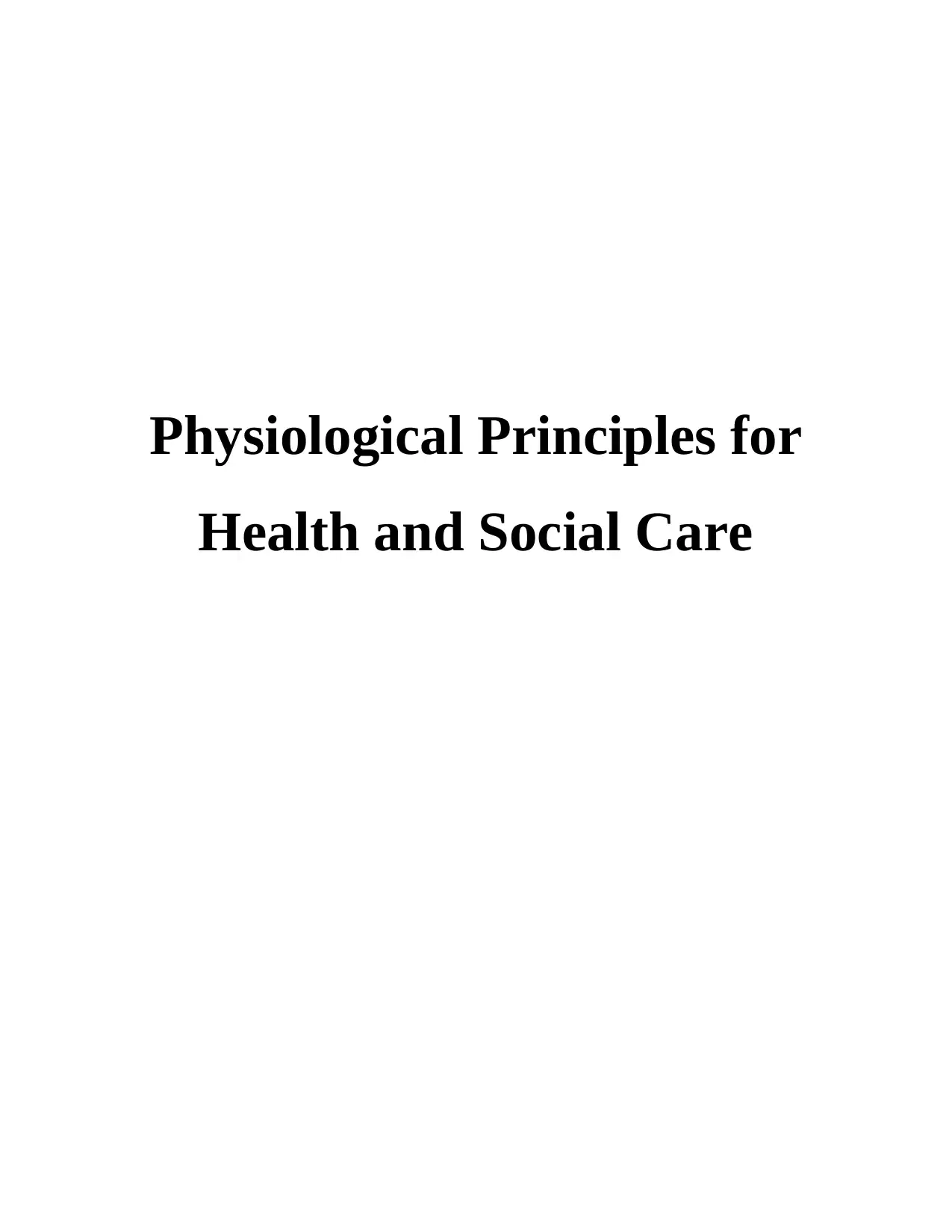
Physiological Principles for
Health and Social Care
Health and Social Care
Paraphrase This Document
Need a fresh take? Get an instant paraphrase of this document with our AI Paraphraser
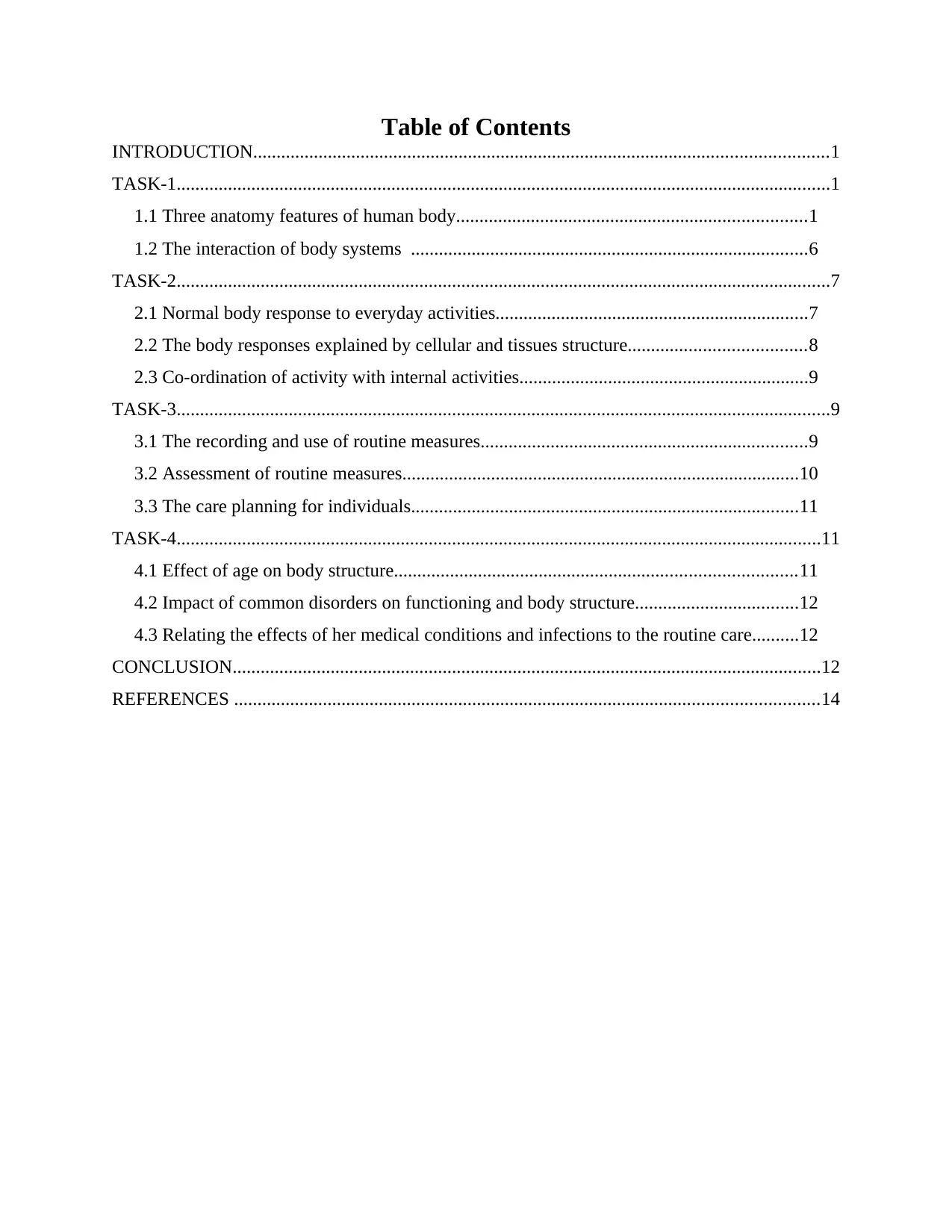
Table of Contents
INTRODUCTION...........................................................................................................................1
TASK-1............................................................................................................................................1
1.1 Three anatomy features of human body...........................................................................1
1.2 The interaction of body systems .....................................................................................6
TASK-2............................................................................................................................................7
2.1 Normal body response to everyday activities...................................................................7
2.2 The body responses explained by cellular and tissues structure......................................8
2.3 Co-ordination of activity with internal activities..............................................................9
TASK-3............................................................................................................................................9
3.1 The recording and use of routine measures......................................................................9
3.2 Assessment of routine measures.....................................................................................10
3.3 The care planning for individuals...................................................................................11
TASK-4..........................................................................................................................................11
4.1 Effect of age on body structure......................................................................................11
4.2 Impact of common disorders on functioning and body structure...................................12
4.3 Relating the effects of her medical conditions and infections to the routine care..........12
CONCLUSION..............................................................................................................................12
REFERENCES .............................................................................................................................14
INTRODUCTION...........................................................................................................................1
TASK-1............................................................................................................................................1
1.1 Three anatomy features of human body...........................................................................1
1.2 The interaction of body systems .....................................................................................6
TASK-2............................................................................................................................................7
2.1 Normal body response to everyday activities...................................................................7
2.2 The body responses explained by cellular and tissues structure......................................8
2.3 Co-ordination of activity with internal activities..............................................................9
TASK-3............................................................................................................................................9
3.1 The recording and use of routine measures......................................................................9
3.2 Assessment of routine measures.....................................................................................10
3.3 The care planning for individuals...................................................................................11
TASK-4..........................................................................................................................................11
4.1 Effect of age on body structure......................................................................................11
4.2 Impact of common disorders on functioning and body structure...................................12
4.3 Relating the effects of her medical conditions and infections to the routine care..........12
CONCLUSION..............................................................................................................................12
REFERENCES .............................................................................................................................14
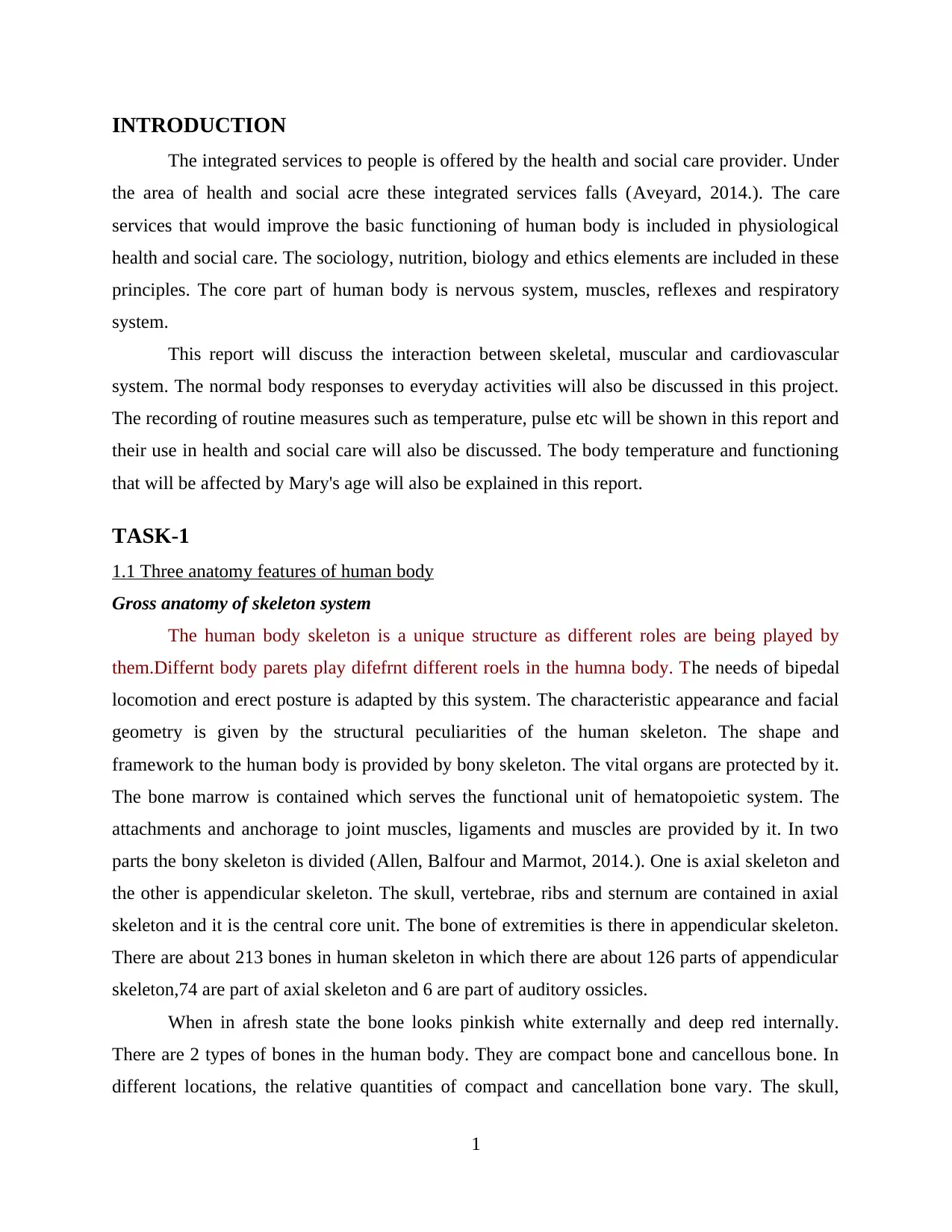
INTRODUCTION
The integrated services to people is offered by the health and social care provider. Under
the area of health and social acre these integrated services falls (Aveyard, 2014.). The care
services that would improve the basic functioning of human body is included in physiological
health and social care. The sociology, nutrition, biology and ethics elements are included in these
principles. The core part of human body is nervous system, muscles, reflexes and respiratory
system.
This report will discuss the interaction between skeletal, muscular and cardiovascular
system. The normal body responses to everyday activities will also be discussed in this project.
The recording of routine measures such as temperature, pulse etc will be shown in this report and
their use in health and social care will also be discussed. The body temperature and functioning
that will be affected by Mary's age will also be explained in this report.
TASK-1
1.1 Three anatomy features of human body
Gross anatomy of skeleton system
The human body skeleton is a unique structure as different roles are being played by
them.Differnt body parets play difefrnt different roels in the humna body. The needs of bipedal
locomotion and erect posture is adapted by this system. The characteristic appearance and facial
geometry is given by the structural peculiarities of the human skeleton. The shape and
framework to the human body is provided by bony skeleton. The vital organs are protected by it.
The bone marrow is contained which serves the functional unit of hematopoietic system. The
attachments and anchorage to joint muscles, ligaments and muscles are provided by it. In two
parts the bony skeleton is divided (Allen, Balfour and Marmot, 2014.). One is axial skeleton and
the other is appendicular skeleton. The skull, vertebrae, ribs and sternum are contained in axial
skeleton and it is the central core unit. The bone of extremities is there in appendicular skeleton.
There are about 213 bones in human skeleton in which there are about 126 parts of appendicular
skeleton,74 are part of axial skeleton and 6 are part of auditory ossicles.
When in afresh state the bone looks pinkish white externally and deep red internally.
There are 2 types of bones in the human body. They are compact bone and cancellous bone. In
different locations, the relative quantities of compact and cancellation bone vary. The skull,
1
The integrated services to people is offered by the health and social care provider. Under
the area of health and social acre these integrated services falls (Aveyard, 2014.). The care
services that would improve the basic functioning of human body is included in physiological
health and social care. The sociology, nutrition, biology and ethics elements are included in these
principles. The core part of human body is nervous system, muscles, reflexes and respiratory
system.
This report will discuss the interaction between skeletal, muscular and cardiovascular
system. The normal body responses to everyday activities will also be discussed in this project.
The recording of routine measures such as temperature, pulse etc will be shown in this report and
their use in health and social care will also be discussed. The body temperature and functioning
that will be affected by Mary's age will also be explained in this report.
TASK-1
1.1 Three anatomy features of human body
Gross anatomy of skeleton system
The human body skeleton is a unique structure as different roles are being played by
them.Differnt body parets play difefrnt different roels in the humna body. The needs of bipedal
locomotion and erect posture is adapted by this system. The characteristic appearance and facial
geometry is given by the structural peculiarities of the human skeleton. The shape and
framework to the human body is provided by bony skeleton. The vital organs are protected by it.
The bone marrow is contained which serves the functional unit of hematopoietic system. The
attachments and anchorage to joint muscles, ligaments and muscles are provided by it. In two
parts the bony skeleton is divided (Allen, Balfour and Marmot, 2014.). One is axial skeleton and
the other is appendicular skeleton. The skull, vertebrae, ribs and sternum are contained in axial
skeleton and it is the central core unit. The bone of extremities is there in appendicular skeleton.
There are about 213 bones in human skeleton in which there are about 126 parts of appendicular
skeleton,74 are part of axial skeleton and 6 are part of auditory ossicles.
When in afresh state the bone looks pinkish white externally and deep red internally.
There are 2 types of bones in the human body. They are compact bone and cancellous bone. In
different locations, the relative quantities of compact and cancellation bone vary. The skull,
1
⊘ This is a preview!⊘
Do you want full access?
Subscribe today to unlock all pages.

Trusted by 1+ million students worldwide
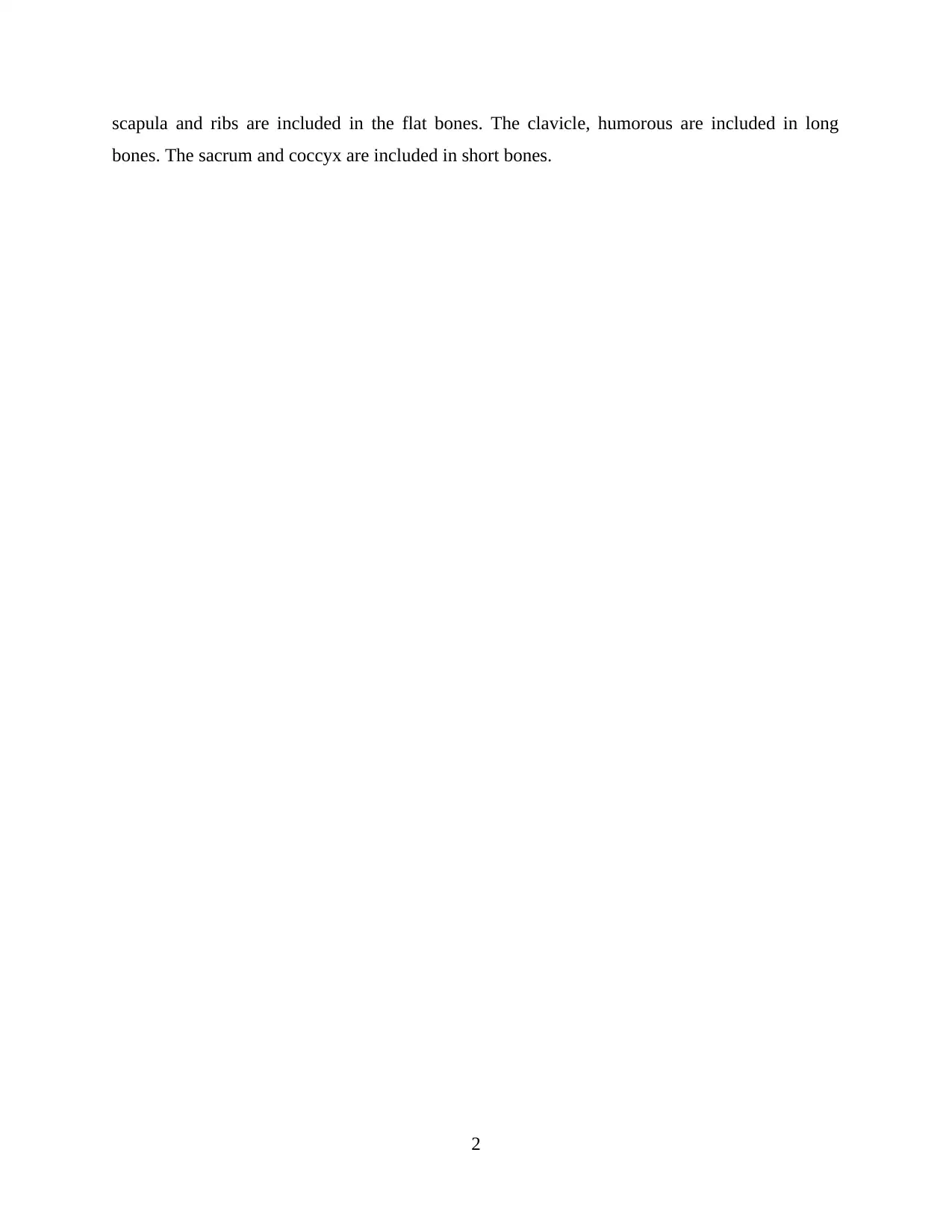
scapula and ribs are included in the flat bones. The clavicle, humorous are included in long
bones. The sacrum and coccyx are included in short bones.
2
bones. The sacrum and coccyx are included in short bones.
2
Paraphrase This Document
Need a fresh take? Get an instant paraphrase of this document with our AI Paraphraser
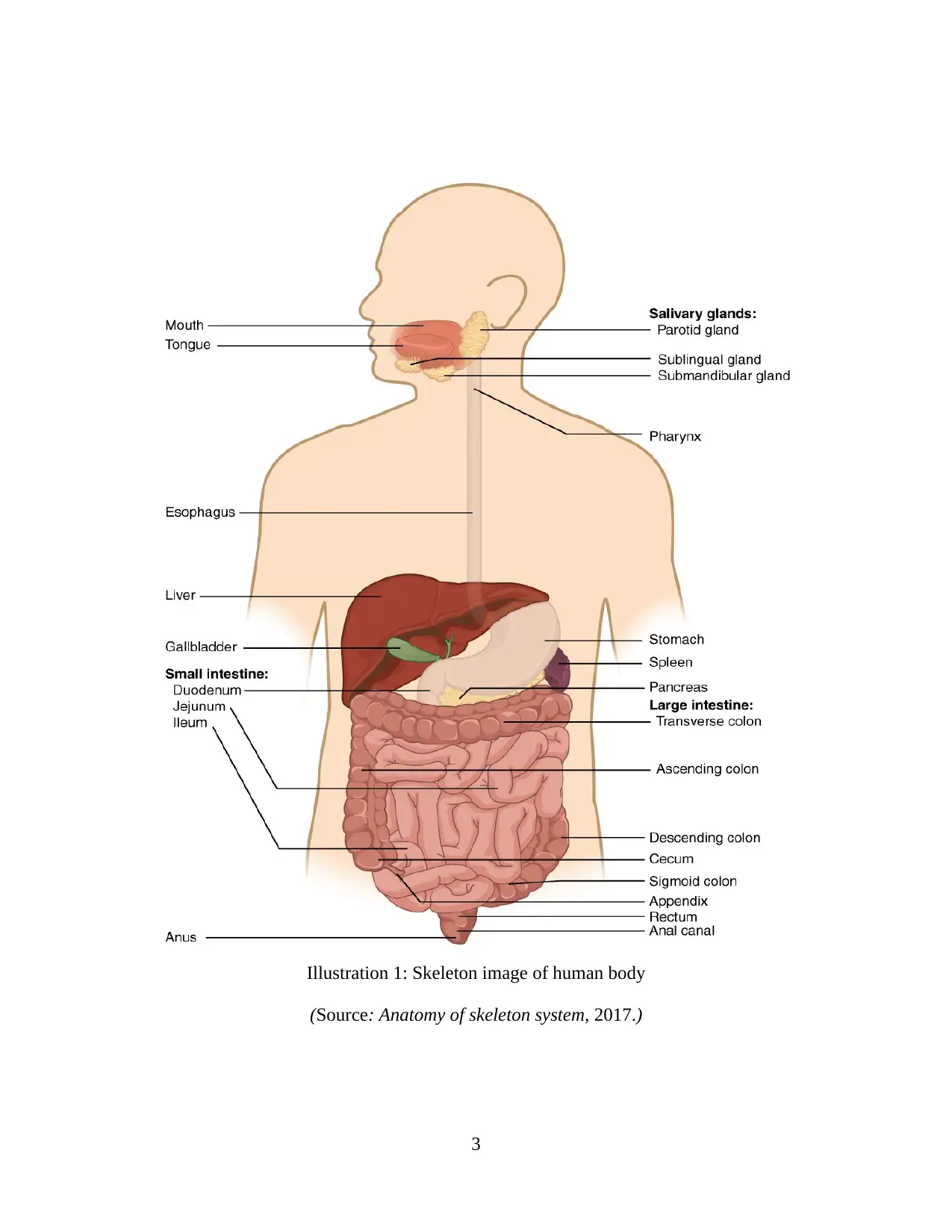
Illustration 1: Skeleton image of human body
(Source: Anatomy of skeleton system, 2017.)
3
(Source: Anatomy of skeleton system, 2017.)
3
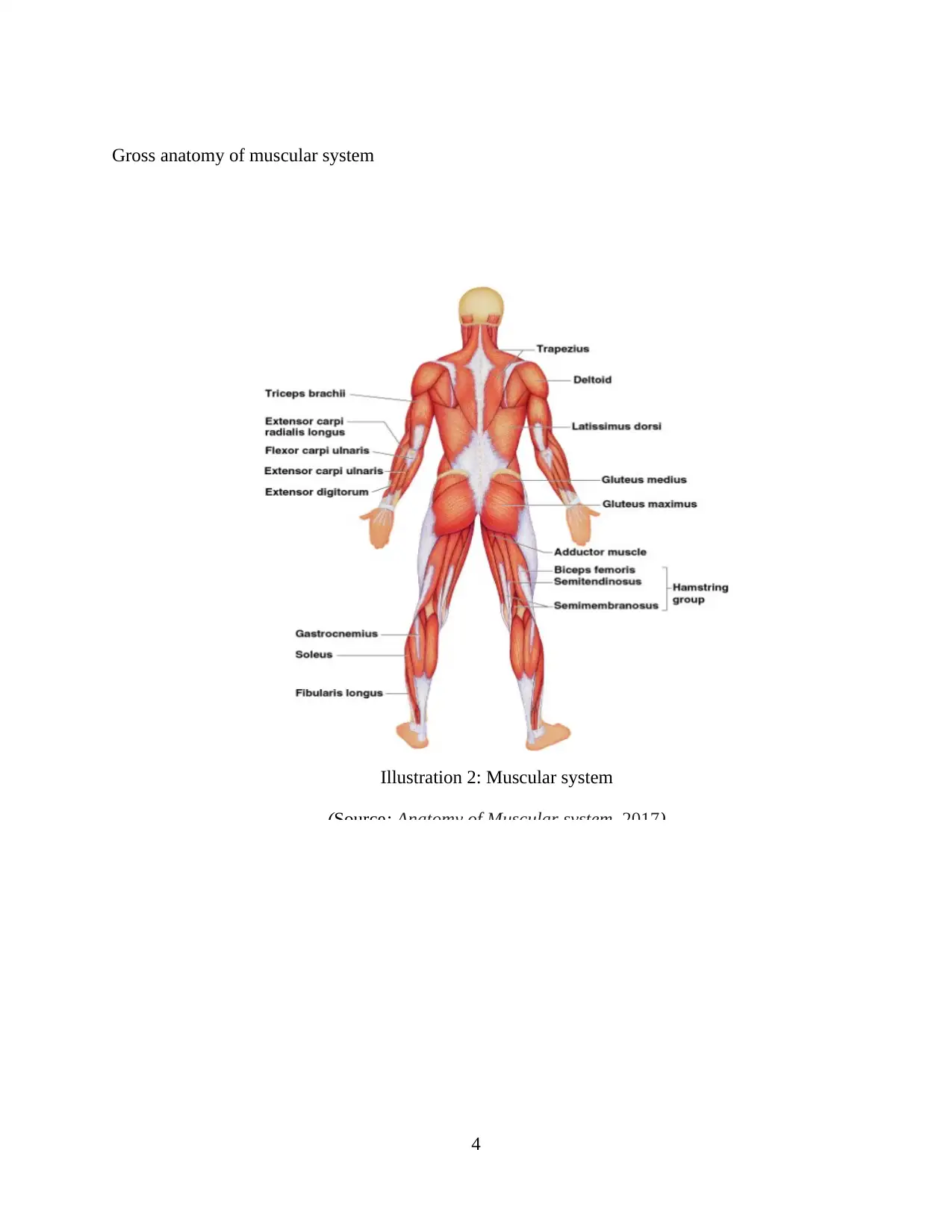
Gross anatomy of muscular system
4
Illustration 2: Muscular system
(Source: Anatomy of Muscular system, 2017)
4
Illustration 2: Muscular system
(Source: Anatomy of Muscular system, 2017)
⊘ This is a preview!⊘
Do you want full access?
Subscribe today to unlock all pages.

Trusted by 1+ million students worldwide
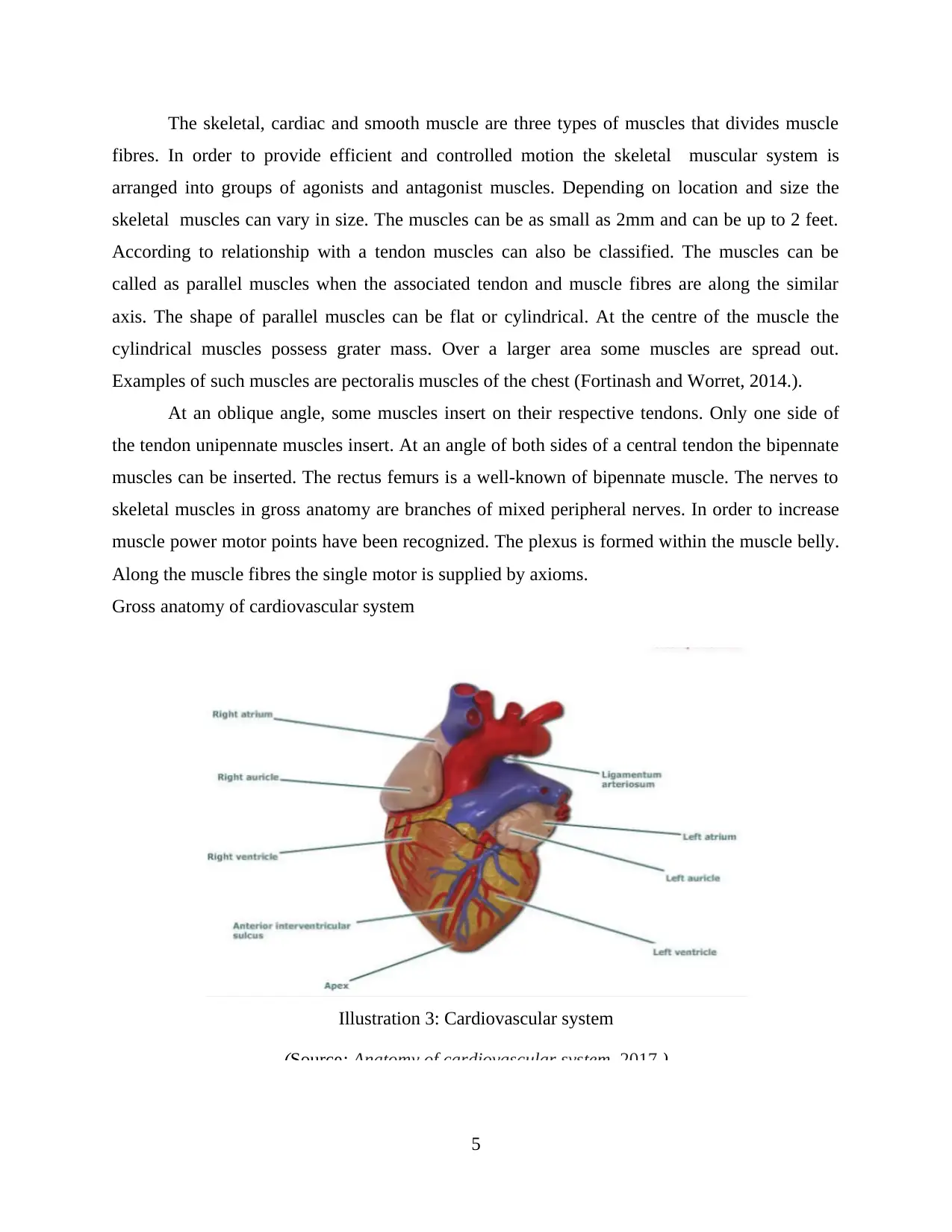
The skeletal, cardiac and smooth muscle are three types of muscles that divides muscle
fibres. In order to provide efficient and controlled motion the skeletal muscular system is
arranged into groups of agonists and antagonist muscles. Depending on location and size the
skeletal muscles can vary in size. The muscles can be as small as 2mm and can be up to 2 feet.
According to relationship with a tendon muscles can also be classified. The muscles can be
called as parallel muscles when the associated tendon and muscle fibres are along the similar
axis. The shape of parallel muscles can be flat or cylindrical. At the centre of the muscle the
cylindrical muscles possess grater mass. Over a larger area some muscles are spread out.
Examples of such muscles are pectoralis muscles of the chest (Fortinash and Worret, 2014.).
At an oblique angle, some muscles insert on their respective tendons. Only one side of
the tendon unipennate muscles insert. At an angle of both sides of a central tendon the bipennate
muscles can be inserted. The rectus femurs is a well-known of bipennate muscle. The nerves to
skeletal muscles in gross anatomy are branches of mixed peripheral nerves. In order to increase
muscle power motor points have been recognized. The plexus is formed within the muscle belly.
Along the muscle fibres the single motor is supplied by axioms.
Gross anatomy of cardiovascular system
5
Illustration 3: Cardiovascular system
(Source: Anatomy of cardiovascular system, 2017.)
fibres. In order to provide efficient and controlled motion the skeletal muscular system is
arranged into groups of agonists and antagonist muscles. Depending on location and size the
skeletal muscles can vary in size. The muscles can be as small as 2mm and can be up to 2 feet.
According to relationship with a tendon muscles can also be classified. The muscles can be
called as parallel muscles when the associated tendon and muscle fibres are along the similar
axis. The shape of parallel muscles can be flat or cylindrical. At the centre of the muscle the
cylindrical muscles possess grater mass. Over a larger area some muscles are spread out.
Examples of such muscles are pectoralis muscles of the chest (Fortinash and Worret, 2014.).
At an oblique angle, some muscles insert on their respective tendons. Only one side of
the tendon unipennate muscles insert. At an angle of both sides of a central tendon the bipennate
muscles can be inserted. The rectus femurs is a well-known of bipennate muscle. The nerves to
skeletal muscles in gross anatomy are branches of mixed peripheral nerves. In order to increase
muscle power motor points have been recognized. The plexus is formed within the muscle belly.
Along the muscle fibres the single motor is supplied by axioms.
Gross anatomy of cardiovascular system
5
Illustration 3: Cardiovascular system
(Source: Anatomy of cardiovascular system, 2017.)
Paraphrase This Document
Need a fresh take? Get an instant paraphrase of this document with our AI Paraphraser
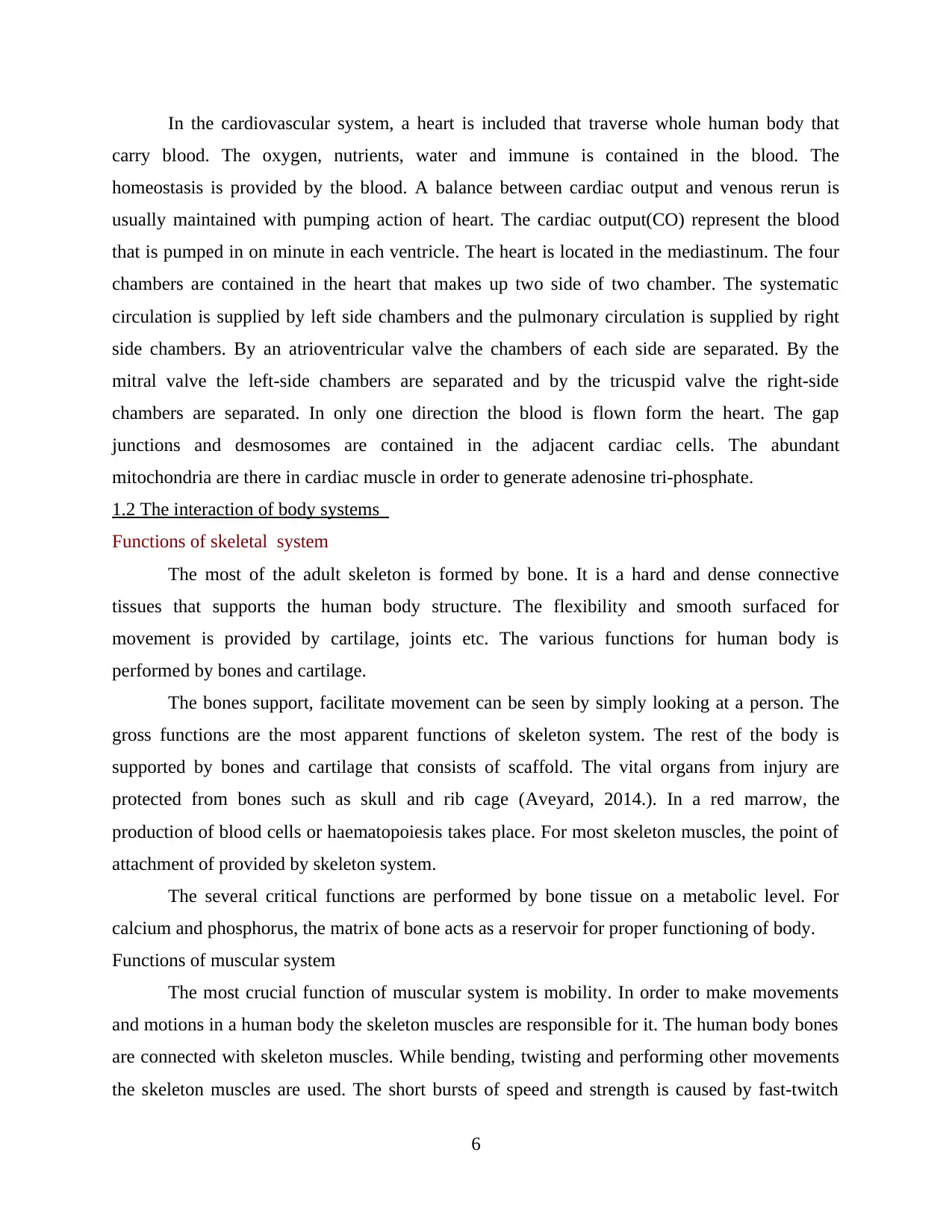
In the cardiovascular system, a heart is included that traverse whole human body that
carry blood. The oxygen, nutrients, water and immune is contained in the blood. The
homeostasis is provided by the blood. A balance between cardiac output and venous rerun is
usually maintained with pumping action of heart. The cardiac output(CO) represent the blood
that is pumped in on minute in each ventricle. The heart is located in the mediastinum. The four
chambers are contained in the heart that makes up two side of two chamber. The systematic
circulation is supplied by left side chambers and the pulmonary circulation is supplied by right
side chambers. By an atrioventricular valve the chambers of each side are separated. By the
mitral valve the left-side chambers are separated and by the tricuspid valve the right-side
chambers are separated. In only one direction the blood is flown form the heart. The gap
junctions and desmosomes are contained in the adjacent cardiac cells. The abundant
mitochondria are there in cardiac muscle in order to generate adenosine tri-phosphate.
1.2 The interaction of body systems
Functions of skeletal system
The most of the adult skeleton is formed by bone. It is a hard and dense connective
tissues that supports the human body structure. The flexibility and smooth surfaced for
movement is provided by cartilage, joints etc. The various functions for human body is
performed by bones and cartilage.
The bones support, facilitate movement can be seen by simply looking at a person. The
gross functions are the most apparent functions of skeleton system. The rest of the body is
supported by bones and cartilage that consists of scaffold. The vital organs from injury are
protected from bones such as skull and rib cage (Aveyard, 2014.). In a red marrow, the
production of blood cells or haematopoiesis takes place. For most skeleton muscles, the point of
attachment of provided by skeleton system.
The several critical functions are performed by bone tissue on a metabolic level. For
calcium and phosphorus, the matrix of bone acts as a reservoir for proper functioning of body.
Functions of muscular system
The most crucial function of muscular system is mobility. In order to make movements
and motions in a human body the skeleton muscles are responsible for it. The human body bones
are connected with skeleton muscles. While bending, twisting and performing other movements
the skeleton muscles are used. The short bursts of speed and strength is caused by fast-twitch
6
carry blood. The oxygen, nutrients, water and immune is contained in the blood. The
homeostasis is provided by the blood. A balance between cardiac output and venous rerun is
usually maintained with pumping action of heart. The cardiac output(CO) represent the blood
that is pumped in on minute in each ventricle. The heart is located in the mediastinum. The four
chambers are contained in the heart that makes up two side of two chamber. The systematic
circulation is supplied by left side chambers and the pulmonary circulation is supplied by right
side chambers. By an atrioventricular valve the chambers of each side are separated. By the
mitral valve the left-side chambers are separated and by the tricuspid valve the right-side
chambers are separated. In only one direction the blood is flown form the heart. The gap
junctions and desmosomes are contained in the adjacent cardiac cells. The abundant
mitochondria are there in cardiac muscle in order to generate adenosine tri-phosphate.
1.2 The interaction of body systems
Functions of skeletal system
The most of the adult skeleton is formed by bone. It is a hard and dense connective
tissues that supports the human body structure. The flexibility and smooth surfaced for
movement is provided by cartilage, joints etc. The various functions for human body is
performed by bones and cartilage.
The bones support, facilitate movement can be seen by simply looking at a person. The
gross functions are the most apparent functions of skeleton system. The rest of the body is
supported by bones and cartilage that consists of scaffold. The vital organs from injury are
protected from bones such as skull and rib cage (Aveyard, 2014.). In a red marrow, the
production of blood cells or haematopoiesis takes place. For most skeleton muscles, the point of
attachment of provided by skeleton system.
The several critical functions are performed by bone tissue on a metabolic level. For
calcium and phosphorus, the matrix of bone acts as a reservoir for proper functioning of body.
Functions of muscular system
The most crucial function of muscular system is mobility. In order to make movements
and motions in a human body the skeleton muscles are responsible for it. The human body bones
are connected with skeleton muscles. While bending, twisting and performing other movements
the skeleton muscles are used. The short bursts of speed and strength is caused by fast-twitch
6
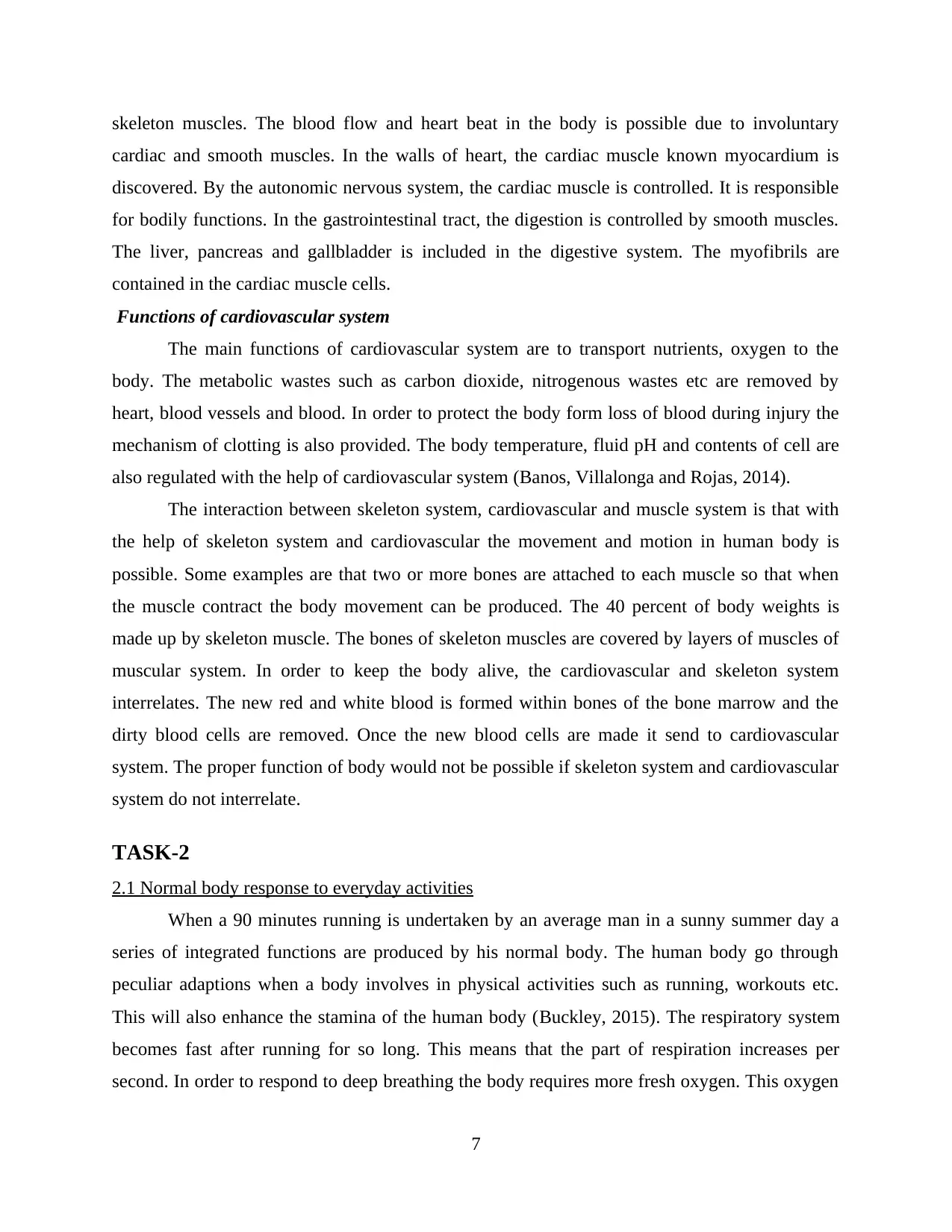
skeleton muscles. The blood flow and heart beat in the body is possible due to involuntary
cardiac and smooth muscles. In the walls of heart, the cardiac muscle known myocardium is
discovered. By the autonomic nervous system, the cardiac muscle is controlled. It is responsible
for bodily functions. In the gastrointestinal tract, the digestion is controlled by smooth muscles.
The liver, pancreas and gallbladder is included in the digestive system. The myofibrils are
contained in the cardiac muscle cells.
Functions of cardiovascular system
The main functions of cardiovascular system are to transport nutrients, oxygen to the
body. The metabolic wastes such as carbon dioxide, nitrogenous wastes etc are removed by
heart, blood vessels and blood. In order to protect the body form loss of blood during injury the
mechanism of clotting is also provided. The body temperature, fluid pH and contents of cell are
also regulated with the help of cardiovascular system (Banos, Villalonga and Rojas, 2014).
The interaction between skeleton system, cardiovascular and muscle system is that with
the help of skeleton system and cardiovascular the movement and motion in human body is
possible. Some examples are that two or more bones are attached to each muscle so that when
the muscle contract the body movement can be produced. The 40 percent of body weights is
made up by skeleton muscle. The bones of skeleton muscles are covered by layers of muscles of
muscular system. In order to keep the body alive, the cardiovascular and skeleton system
interrelates. The new red and white blood is formed within bones of the bone marrow and the
dirty blood cells are removed. Once the new blood cells are made it send to cardiovascular
system. The proper function of body would not be possible if skeleton system and cardiovascular
system do not interrelate.
TASK-2
2.1 Normal body response to everyday activities
When a 90 minutes running is undertaken by an average man in a sunny summer day a
series of integrated functions are produced by his normal body. The human body go through
peculiar adaptions when a body involves in physical activities such as running, workouts etc.
This will also enhance the stamina of the human body (Buckley, 2015). The respiratory system
becomes fast after running for so long. This means that the part of respiration increases per
second. In order to respond to deep breathing the body requires more fresh oxygen. This oxygen
7
cardiac and smooth muscles. In the walls of heart, the cardiac muscle known myocardium is
discovered. By the autonomic nervous system, the cardiac muscle is controlled. It is responsible
for bodily functions. In the gastrointestinal tract, the digestion is controlled by smooth muscles.
The liver, pancreas and gallbladder is included in the digestive system. The myofibrils are
contained in the cardiac muscle cells.
Functions of cardiovascular system
The main functions of cardiovascular system are to transport nutrients, oxygen to the
body. The metabolic wastes such as carbon dioxide, nitrogenous wastes etc are removed by
heart, blood vessels and blood. In order to protect the body form loss of blood during injury the
mechanism of clotting is also provided. The body temperature, fluid pH and contents of cell are
also regulated with the help of cardiovascular system (Banos, Villalonga and Rojas, 2014).
The interaction between skeleton system, cardiovascular and muscle system is that with
the help of skeleton system and cardiovascular the movement and motion in human body is
possible. Some examples are that two or more bones are attached to each muscle so that when
the muscle contract the body movement can be produced. The 40 percent of body weights is
made up by skeleton muscle. The bones of skeleton muscles are covered by layers of muscles of
muscular system. In order to keep the body alive, the cardiovascular and skeleton system
interrelates. The new red and white blood is formed within bones of the bone marrow and the
dirty blood cells are removed. Once the new blood cells are made it send to cardiovascular
system. The proper function of body would not be possible if skeleton system and cardiovascular
system do not interrelate.
TASK-2
2.1 Normal body response to everyday activities
When a 90 minutes running is undertaken by an average man in a sunny summer day a
series of integrated functions are produced by his normal body. The human body go through
peculiar adaptions when a body involves in physical activities such as running, workouts etc.
This will also enhance the stamina of the human body (Buckley, 2015). The respiratory system
becomes fast after running for so long. This means that the part of respiration increases per
second. In order to respond to deep breathing the body requires more fresh oxygen. This oxygen
7
⊘ This is a preview!⊘
Do you want full access?
Subscribe today to unlock all pages.

Trusted by 1+ million students worldwide
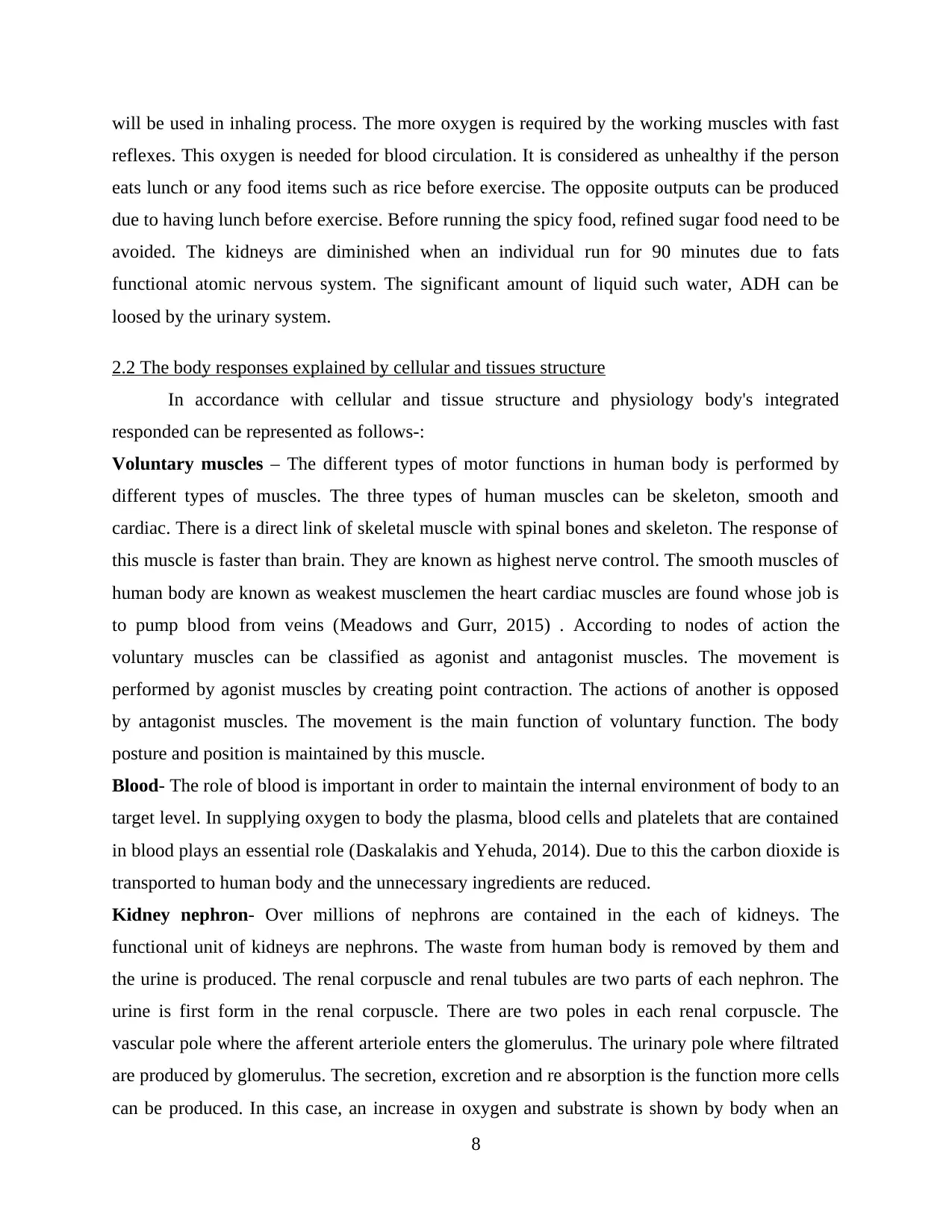
will be used in inhaling process. The more oxygen is required by the working muscles with fast
reflexes. This oxygen is needed for blood circulation. It is considered as unhealthy if the person
eats lunch or any food items such as rice before exercise. The opposite outputs can be produced
due to having lunch before exercise. Before running the spicy food, refined sugar food need to be
avoided. The kidneys are diminished when an individual run for 90 minutes due to fats
functional atomic nervous system. The significant amount of liquid such water, ADH can be
loosed by the urinary system.
2.2 The body responses explained by cellular and tissues structure
In accordance with cellular and tissue structure and physiology body's integrated
responded can be represented as follows-:
Voluntary muscles – The different types of motor functions in human body is performed by
different types of muscles. The three types of human muscles can be skeleton, smooth and
cardiac. There is a direct link of skeletal muscle with spinal bones and skeleton. The response of
this muscle is faster than brain. They are known as highest nerve control. The smooth muscles of
human body are known as weakest musclemen the heart cardiac muscles are found whose job is
to pump blood from veins (Meadows and Gurr, 2015) . According to nodes of action the
voluntary muscles can be classified as agonist and antagonist muscles. The movement is
performed by agonist muscles by creating point contraction. The actions of another is opposed
by antagonist muscles. The movement is the main function of voluntary function. The body
posture and position is maintained by this muscle.
Blood- The role of blood is important in order to maintain the internal environment of body to an
target level. In supplying oxygen to body the plasma, blood cells and platelets that are contained
in blood plays an essential role (Daskalakis and Yehuda, 2014). Due to this the carbon dioxide is
transported to human body and the unnecessary ingredients are reduced.
Kidney nephron- Over millions of nephrons are contained in the each of kidneys. The
functional unit of kidneys are nephrons. The waste from human body is removed by them and
the urine is produced. The renal corpuscle and renal tubules are two parts of each nephron. The
urine is first form in the renal corpuscle. There are two poles in each renal corpuscle. The
vascular pole where the afferent arteriole enters the glomerulus. The urinary pole where filtrated
are produced by glomerulus. The secretion, excretion and re absorption is the function more cells
can be produced. In this case, an increase in oxygen and substrate is shown by body when an
8
reflexes. This oxygen is needed for blood circulation. It is considered as unhealthy if the person
eats lunch or any food items such as rice before exercise. The opposite outputs can be produced
due to having lunch before exercise. Before running the spicy food, refined sugar food need to be
avoided. The kidneys are diminished when an individual run for 90 minutes due to fats
functional atomic nervous system. The significant amount of liquid such water, ADH can be
loosed by the urinary system.
2.2 The body responses explained by cellular and tissues structure
In accordance with cellular and tissue structure and physiology body's integrated
responded can be represented as follows-:
Voluntary muscles – The different types of motor functions in human body is performed by
different types of muscles. The three types of human muscles can be skeleton, smooth and
cardiac. There is a direct link of skeletal muscle with spinal bones and skeleton. The response of
this muscle is faster than brain. They are known as highest nerve control. The smooth muscles of
human body are known as weakest musclemen the heart cardiac muscles are found whose job is
to pump blood from veins (Meadows and Gurr, 2015) . According to nodes of action the
voluntary muscles can be classified as agonist and antagonist muscles. The movement is
performed by agonist muscles by creating point contraction. The actions of another is opposed
by antagonist muscles. The movement is the main function of voluntary function. The body
posture and position is maintained by this muscle.
Blood- The role of blood is important in order to maintain the internal environment of body to an
target level. In supplying oxygen to body the plasma, blood cells and platelets that are contained
in blood plays an essential role (Daskalakis and Yehuda, 2014). Due to this the carbon dioxide is
transported to human body and the unnecessary ingredients are reduced.
Kidney nephron- Over millions of nephrons are contained in the each of kidneys. The
functional unit of kidneys are nephrons. The waste from human body is removed by them and
the urine is produced. The renal corpuscle and renal tubules are two parts of each nephron. The
urine is first form in the renal corpuscle. There are two poles in each renal corpuscle. The
vascular pole where the afferent arteriole enters the glomerulus. The urinary pole where filtrated
are produced by glomerulus. The secretion, excretion and re absorption is the function more cells
can be produced. In this case, an increase in oxygen and substrate is shown by body when an
8
Paraphrase This Document
Need a fresh take? Get an instant paraphrase of this document with our AI Paraphraser
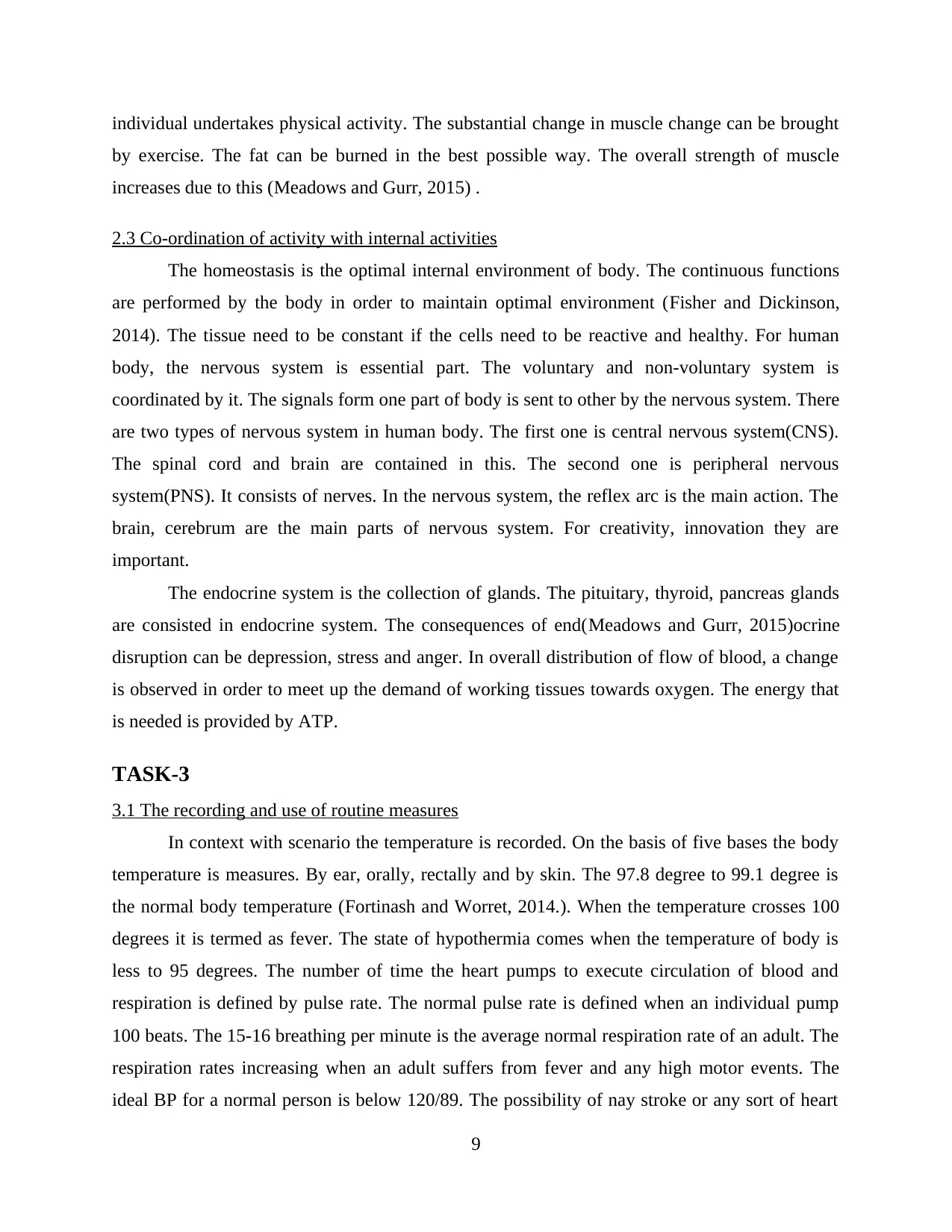
individual undertakes physical activity. The substantial change in muscle change can be brought
by exercise. The fat can be burned in the best possible way. The overall strength of muscle
increases due to this (Meadows and Gurr, 2015) .
2.3 Co-ordination of activity with internal activities
The homeostasis is the optimal internal environment of body. The continuous functions
are performed by the body in order to maintain optimal environment (Fisher and Dickinson,
2014). The tissue need to be constant if the cells need to be reactive and healthy. For human
body, the nervous system is essential part. The voluntary and non-voluntary system is
coordinated by it. The signals form one part of body is sent to other by the nervous system. There
are two types of nervous system in human body. The first one is central nervous system(CNS).
The spinal cord and brain are contained in this. The second one is peripheral nervous
system(PNS). It consists of nerves. In the nervous system, the reflex arc is the main action. The
brain, cerebrum are the main parts of nervous system. For creativity, innovation they are
important.
The endocrine system is the collection of glands. The pituitary, thyroid, pancreas glands
are consisted in endocrine system. The consequences of end(Meadows and Gurr, 2015)ocrine
disruption can be depression, stress and anger. In overall distribution of flow of blood, a change
is observed in order to meet up the demand of working tissues towards oxygen. The energy that
is needed is provided by ATP.
TASK-3
3.1 The recording and use of routine measures
In context with scenario the temperature is recorded. On the basis of five bases the body
temperature is measures. By ear, orally, rectally and by skin. The 97.8 degree to 99.1 degree is
the normal body temperature (Fortinash and Worret, 2014.). When the temperature crosses 100
degrees it is termed as fever. The state of hypothermia comes when the temperature of body is
less to 95 degrees. The number of time the heart pumps to execute circulation of blood and
respiration is defined by pulse rate. The normal pulse rate is defined when an individual pump
100 beats. The 15-16 breathing per minute is the average normal respiration rate of an adult. The
respiration rates increasing when an adult suffers from fever and any high motor events. The
ideal BP for a normal person is below 120/89. The possibility of nay stroke or any sort of heart
9
by exercise. The fat can be burned in the best possible way. The overall strength of muscle
increases due to this (Meadows and Gurr, 2015) .
2.3 Co-ordination of activity with internal activities
The homeostasis is the optimal internal environment of body. The continuous functions
are performed by the body in order to maintain optimal environment (Fisher and Dickinson,
2014). The tissue need to be constant if the cells need to be reactive and healthy. For human
body, the nervous system is essential part. The voluntary and non-voluntary system is
coordinated by it. The signals form one part of body is sent to other by the nervous system. There
are two types of nervous system in human body. The first one is central nervous system(CNS).
The spinal cord and brain are contained in this. The second one is peripheral nervous
system(PNS). It consists of nerves. In the nervous system, the reflex arc is the main action. The
brain, cerebrum are the main parts of nervous system. For creativity, innovation they are
important.
The endocrine system is the collection of glands. The pituitary, thyroid, pancreas glands
are consisted in endocrine system. The consequences of end(Meadows and Gurr, 2015)ocrine
disruption can be depression, stress and anger. In overall distribution of flow of blood, a change
is observed in order to meet up the demand of working tissues towards oxygen. The energy that
is needed is provided by ATP.
TASK-3
3.1 The recording and use of routine measures
In context with scenario the temperature is recorded. On the basis of five bases the body
temperature is measures. By ear, orally, rectally and by skin. The 97.8 degree to 99.1 degree is
the normal body temperature (Fortinash and Worret, 2014.). When the temperature crosses 100
degrees it is termed as fever. The state of hypothermia comes when the temperature of body is
less to 95 degrees. The number of time the heart pumps to execute circulation of blood and
respiration is defined by pulse rate. The normal pulse rate is defined when an individual pump
100 beats. The 15-16 breathing per minute is the average normal respiration rate of an adult. The
respiration rates increasing when an adult suffers from fever and any high motor events. The
ideal BP for a normal person is below 120/89. The possibility of nay stroke or any sort of heart
9
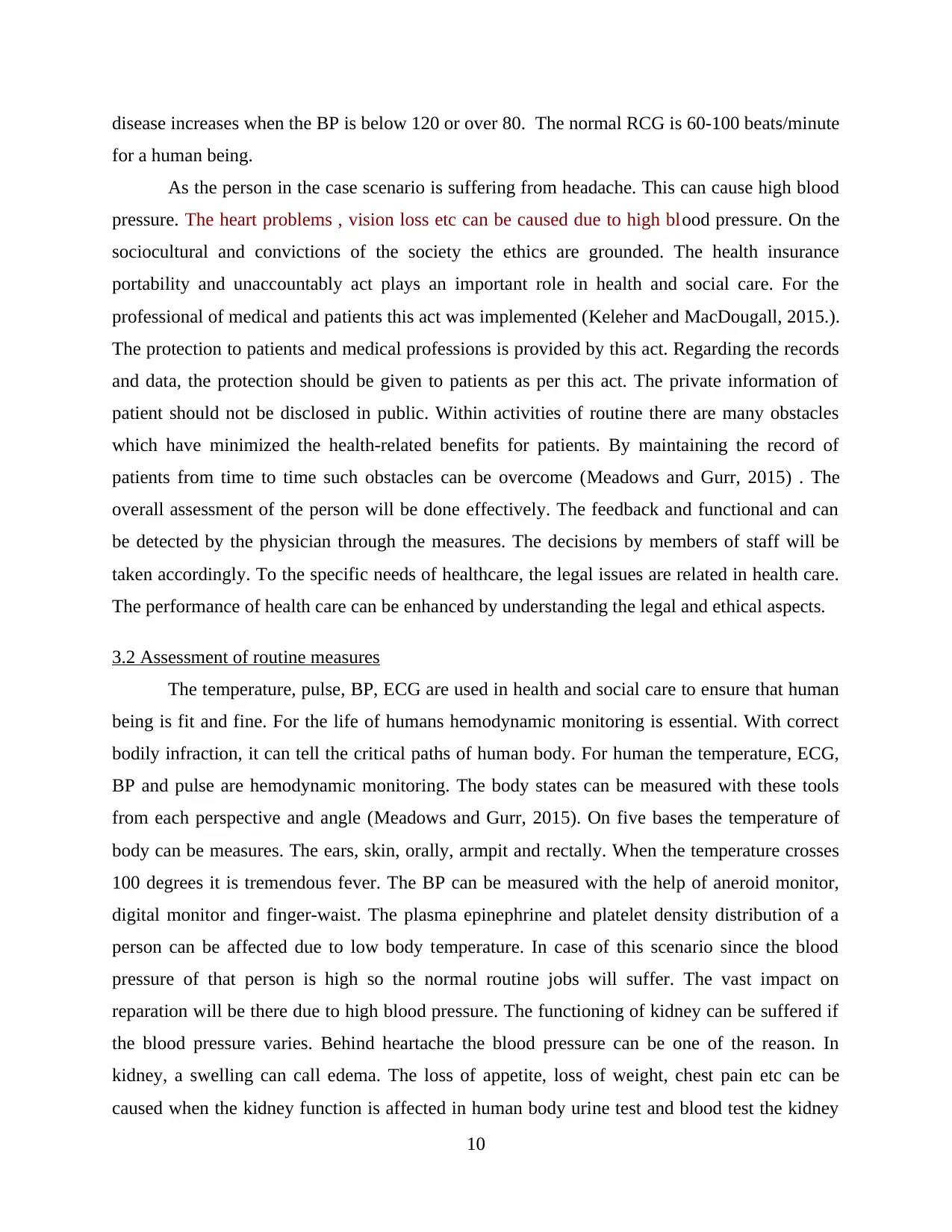
disease increases when the BP is below 120 or over 80. The normal RCG is 60-100 beats/minute
for a human being.
As the person in the case scenario is suffering from headache. This can cause high blood
pressure. The heart problems , vision loss etc can be caused due to high blood pressure. On the
sociocultural and convictions of the society the ethics are grounded. The health insurance
portability and unaccountably act plays an important role in health and social care. For the
professional of medical and patients this act was implemented (Keleher and MacDougall, 2015.).
The protection to patients and medical professions is provided by this act. Regarding the records
and data, the protection should be given to patients as per this act. The private information of
patient should not be disclosed in public. Within activities of routine there are many obstacles
which have minimized the health-related benefits for patients. By maintaining the record of
patients from time to time such obstacles can be overcome (Meadows and Gurr, 2015) . The
overall assessment of the person will be done effectively. The feedback and functional and can
be detected by the physician through the measures. The decisions by members of staff will be
taken accordingly. To the specific needs of healthcare, the legal issues are related in health care.
The performance of health care can be enhanced by understanding the legal and ethical aspects.
3.2 Assessment of routine measures
The temperature, pulse, BP, ECG are used in health and social care to ensure that human
being is fit and fine. For the life of humans hemodynamic monitoring is essential. With correct
bodily infraction, it can tell the critical paths of human body. For human the temperature, ECG,
BP and pulse are hemodynamic monitoring. The body states can be measured with these tools
from each perspective and angle (Meadows and Gurr, 2015). On five bases the temperature of
body can be measures. The ears, skin, orally, armpit and rectally. When the temperature crosses
100 degrees it is tremendous fever. The BP can be measured with the help of aneroid monitor,
digital monitor and finger-waist. The plasma epinephrine and platelet density distribution of a
person can be affected due to low body temperature. In case of this scenario since the blood
pressure of that person is high so the normal routine jobs will suffer. The vast impact on
reparation will be there due to high blood pressure. The functioning of kidney can be suffered if
the blood pressure varies. Behind heartache the blood pressure can be one of the reason. In
kidney, a swelling can call edema. The loss of appetite, loss of weight, chest pain etc can be
caused when the kidney function is affected in human body urine test and blood test the kidney
10
for a human being.
As the person in the case scenario is suffering from headache. This can cause high blood
pressure. The heart problems , vision loss etc can be caused due to high blood pressure. On the
sociocultural and convictions of the society the ethics are grounded. The health insurance
portability and unaccountably act plays an important role in health and social care. For the
professional of medical and patients this act was implemented (Keleher and MacDougall, 2015.).
The protection to patients and medical professions is provided by this act. Regarding the records
and data, the protection should be given to patients as per this act. The private information of
patient should not be disclosed in public. Within activities of routine there are many obstacles
which have minimized the health-related benefits for patients. By maintaining the record of
patients from time to time such obstacles can be overcome (Meadows and Gurr, 2015) . The
overall assessment of the person will be done effectively. The feedback and functional and can
be detected by the physician through the measures. The decisions by members of staff will be
taken accordingly. To the specific needs of healthcare, the legal issues are related in health care.
The performance of health care can be enhanced by understanding the legal and ethical aspects.
3.2 Assessment of routine measures
The temperature, pulse, BP, ECG are used in health and social care to ensure that human
being is fit and fine. For the life of humans hemodynamic monitoring is essential. With correct
bodily infraction, it can tell the critical paths of human body. For human the temperature, ECG,
BP and pulse are hemodynamic monitoring. The body states can be measured with these tools
from each perspective and angle (Meadows and Gurr, 2015). On five bases the temperature of
body can be measures. The ears, skin, orally, armpit and rectally. When the temperature crosses
100 degrees it is tremendous fever. The BP can be measured with the help of aneroid monitor,
digital monitor and finger-waist. The plasma epinephrine and platelet density distribution of a
person can be affected due to low body temperature. In case of this scenario since the blood
pressure of that person is high so the normal routine jobs will suffer. The vast impact on
reparation will be there due to high blood pressure. The functioning of kidney can be suffered if
the blood pressure varies. Behind heartache the blood pressure can be one of the reason. In
kidney, a swelling can call edema. The loss of appetite, loss of weight, chest pain etc can be
caused when the kidney function is affected in human body urine test and blood test the kidney
10
⊘ This is a preview!⊘
Do you want full access?
Subscribe today to unlock all pages.

Trusted by 1+ million students worldwide
1 out of 17
Related Documents
Your All-in-One AI-Powered Toolkit for Academic Success.
+13062052269
info@desklib.com
Available 24*7 on WhatsApp / Email
![[object Object]](/_next/static/media/star-bottom.7253800d.svg)
Unlock your academic potential
Copyright © 2020–2025 A2Z Services. All Rights Reserved. Developed and managed by ZUCOL.




